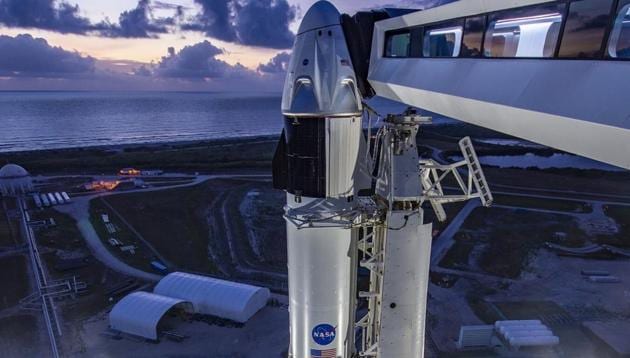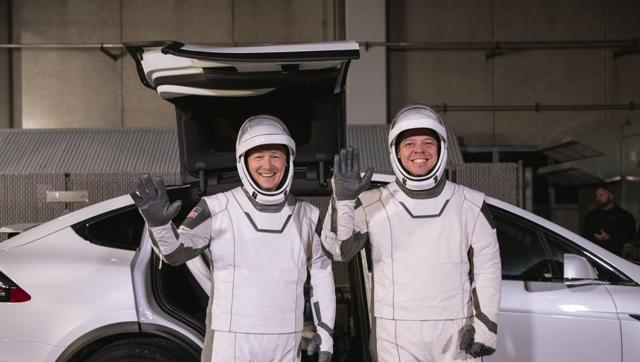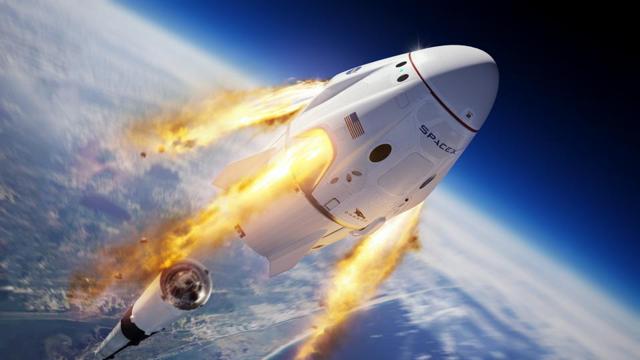SpaceX Crew Dragon’s first manned space flight on May 27: Launch day schedule
Not only will SpaceX’s Crew Dragon spacecraft launching NASA astronauts into orbit be the first such attempt by a private company , but the Demo-2 mission will also be the first time American astronauts will be launched into space from the US soil since NASA ended its shuttle programme in 2011.
A little over 24 hours stand between Elon Musk, his company SpaceX and space history. On May 27, if things go as planned, SpaceX’s first-ever manned space flight is set to launch two NASA astronauts to the International Space Station (ISS) in its Crew Dragon spacecraft atop a Falcon 9 rocket.

Not only will it be the first attempt by a private company to send astronauts into orbit, but the SpaceX flight will also be the first time American astronauts will be launched into space from the US soil since NASA ended its shuttle programme in 2011.
The mission, called Demo-2, will lift off with NASA astronauts Douglas Hurley and Robert Behnken on board, from Pad 39A at the Kennedy Space Centre in Cape Canaveral, Florida, at 4:33 pm EDT (2033 GMT or 2:03 am IST). The Crew Dragon is expected to dock at the ISS about 19 hours later.
US President Donald Trump will be among those at Kennedy Space Centre to witness the launch. NASA has asked general public to watch the launch via a livestream, citing coronavirus pandemic.
If the Demo-2 mission is successful, SpaceX’s Crew Dragon will be certified by NASA for operational, long-duration missions to the space station, according to a statement on the US space agency website, paving the way for privatisation of space travel.
Here’s an explainer of what will happen on May 27, according to website space.com:
Pre-launch operations

Hurley and Behnken will begin their day at NASA’s crew quarters five hours prior to the scheduled launch. After breakfast, they will squeeze into their space suits and get into a shiny Tesla Model X sports car –courtesy Elon Musk who is also the founder of Tesla - for a 9-mile (14-km) ride to the launch pad. The duo is expected to arrive at Pad 39A about three hours before lift-off.
Between the astronauts having breakfast and leaving for the launch pad, the Air Force’s 45th Weather Squadron will check weather conditions and will announce an updated launch forecast. In case the conditions are unfavourable, the launch will be aborted. The next launch date has been fixed for May 30.
Boarding the Dragon Crew Spacecraft
At T-minus 2 hours and 15 minutes, Behnken and Hurley will enter the Crew Dragon spacecraft via a brand-new crew access arm. Ground crews will ensure the astronauts are safely buckled up inside the spacecraft before closing the hatch 25 minutes later. The next time the hatch will open is once the spacecraft docks with ISS.
Liftoff and Separation

After the liftoff at 4:33 pm EDT, it will take about 2.5 minutes for Falcon 9’s first stage booster to separate from the upper stage and begin preparations for a landing back on Earth.
Meanwhile, up in space, just a few seconds after the first stage separation, Falcon 9’s second stage will fire its engine for about six minutes and then will separate from Crew Dragon spacecraft, leaving the Crew Dragon capsule on its own in space for the first time.
The Crew Dragon will use the solar panels built into the body of the spacecraft to power its flight.
Approaching ISS and Docking
Next, the Crew Dragon will perform a series of phasing manoeuvres which will raise its altitude to the altitude of the International Space Station (ISS) – at about 250 miles (400 km) from Earth- so that it can gradually approach and autonomously dock with the ISS.
The Crew Dragon will now enter the “keep-out-sphere” of the ISS - an imaginary 200 m bubble around the space station - and align with the ISS’ docking port at the Pressurised Mating Adaptor PMA-2 on the Harmony module of the ISS. The spacecraft will move very slowly towards the ISS and the entire procedure will be fully autonomous.
And finally, about 19 hours after the liftoff, the Crew Dragon spacecraft is expected to dock with the ISS on Thursday, May 28 at 11:29 am EDT (8:59 pm IST).
Once docked, the astronauts aboard Crew Dragon – Douglas Hurley and Robert Behnken - will be helped by the crew of the ISS to open the hatch at 1:55 pm EDT (11:25pm IST) and enter the space station.
The Demo-2 astronauts will join NASA’s Chris Cassidy and Russian cosmonauts Anatoly Ivanishin and Ivan Vagner who have been at the ISS since April and become members of Expedition 63 crew. They Demo-2 astronauts will perform tests on Crew Dragon in addition to conducting research and other tasks with the space station crew.
According to NASA, although the Crew Dragon can stay in orbit about 110 days, the specific mission duration will be determined once on station based on the readiness of the next commercial crew launch.



